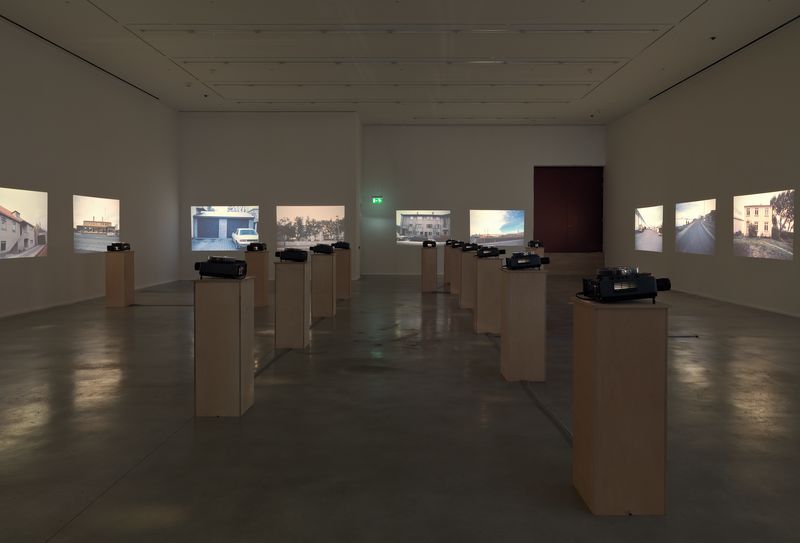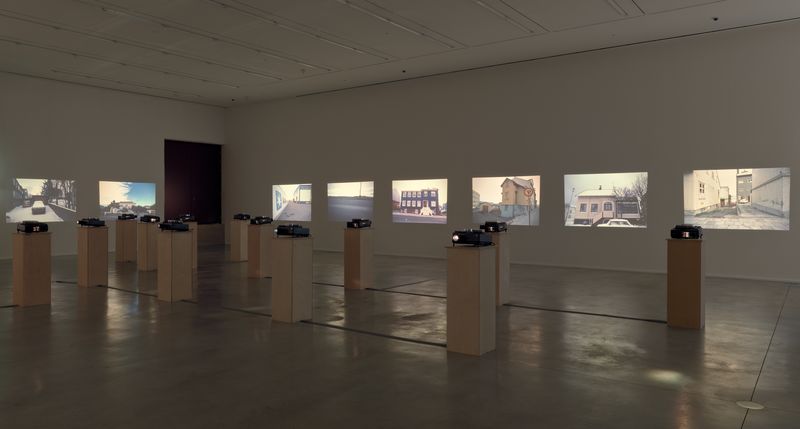
Dieter Roth
Reykjavik Slides (31,035) Every View of a City
17 March - 30 April 2011
London
Throughout his career, Dieter Roth worked with great breadth and diversity. He was a composer, musician, poet and writer as well as an artist, consciously obliterating categories and hierarchies and, through his collaborations with other artists, subverting the principle of authorship. Hauser & Wirth is delighted to present Roth's monumental project 'Reykjavik Slides', on view at Hauser & Wirth London, Savile Row until 30 April 2011. Featuring 31,035 slides shown simultaneously on multiple projectors, 'Reykjavik Slides' was inspired by the distinctive character of Icelandic architecture and documents every building in the capital. Made with the assistance of Pál Magnússon and the artist's two sons, Björn and Karl, the work is a comprehensive survey, drawing one's attention to the subject matter of the project, rather than the role of the artist. In his work from the 1960s and 1970s, Roth liberated himself from formal and linguistic conventions. He pursued the belief that life was art, achieving this through a decision to give all things, however insignificant or unappealing, equal importance. With projects such as 'SNOW' (1963 – 69), a book project that involved the photographing and experimental printing of every object with which Roth came into contact; and 'Flacher Abfall (Flat Waste)' (1975-76 / 1992), a collection of neatly and chronologically archived items less than a third of an inch thick, Roth's strict avoidance of hierarchy developed a unique preservation of the ephemera of his life. These projects advanced a poetic of everyday meaningfulness: 'every slip of paper is touching,' Roth said; 'each day or thing sings its song'. With 'Reykjavik Slides', Roth used this same didactic approach to create an homage to Iceland. The work's numerous images present an act of dedication to the singularity of Reykjavik, Roth's home since 1957 and, in seeing every building as worthy of admiration, Roth allowed life itself to communicate as art.
Installation views


About the Artist

Dieter Roth
One of the most influential artists of the post-World War II period, Dieter Roth was born in Hanover, Germany, in 1930, to a German mother and a Swiss father, and died in Basel, Switzerland in 1998. Dieter Roth was an artist of an immense diversity and breadth, producing books, graphics, drawings, paintings, sculptures, assemblages, installations, audio and media works involving slides, sound recordings, film and video. He also worked as a composer, poet, writer and musician. He often collaborated with other artists, subverting the principle of authorship. Those partners included such significant figures as Richard Hamilton, Emmett Williams, Arnulf Rainer, and Hermann Nitsch. But it was Roth's long and symbiotic collaboration with his son, artist Björn Roth, that stands as testament to the enormous and enduring potency of his restless, relentless process.
Through much of his life, Roth was restlessly peripatetic, moving between studios in many cities. His two primary bases of activity—Iceland and Basel—were decidedly outside the mainstream. Throughout his career, the artist continually circled back to earlier ideas and processes, reinterpreting and transforming works so that linearity and closure are consistently defied. Transience and order, destruction and creativity, playful humor and critical inquiry, the abject and the beautiful, all maintain a consistent balance throughout his work.
Roth represented Switzerland at the 1982 Venice Biennale, and received a number of awards and prizes, including the 1991 Genevan Prix Caran d'Ache Beaux Arts, a prestigious Swiss prize. In 2004, The Museum of Modern Art and P.S.1 Contemporary Art Center in New York City jointly presented the major historical exhibition ‘Roth Time: A Dieter Roth Retrospective,’ a project co-organized with Schaulager Basel, Switzerland, and the Museum Ludwig of Cologne, Germany.
Current Exhibitions
1 / 12














